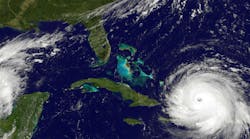Don’t Try to Reason with Hurricane Season: How to Protect the Safety of Your Employees
Hurricanes and other natural disasters threaten different parts of the United States on a regular basis, but too many businesses have no viable plan in place for minimizing the danger to their employees and operations.
This is especially true of hurricanes, according to Howard Mavity, an attorney with the law firm of Fisher Phillips. “Despite the constant news coverage, Americans are inevitably surprised by the violence of hurricanes, and even more by the damage inflicted by storm surges and the extraordinary amounts of rain once the hurricane high winds pass,” he says.
This danger even extends to employees who perform what OSHA calls non-routine tasks—those who engage in recovery and clean-up activities and are trained and equipped to deal with the dangers following the storm’s immediate impact. These dangers range from downed electrical wires, heat exhaustion, exposure to toxic chemicals to snakes and alligators the storm has left behind, in some cases.
Advance planning for disasters is crucial for any business, Mavity notes. “If you are caught flatfooted on this occasion, sadly, you’ll have more opportunities in the future to be well prepared. This is why we harp a great deal on ‘real’ disaster/crisis preparation and business continuity planning and training.”
Mavity offers these tips for employers to follow:
Think before you act. If the work involves non-routine tasks, take the necessary time to conduct a Job Safety Analysis, determine the hazards and provide training and personal protective equipment (PPE).
Emphasize “Situational Awareness” by stressing that supervisors and employees keep their eyes out for unforeseen, hidden and sometimes just plain weird hazards.
Anticipate that disasters never follow the rules and plans. “Expect problems. Be paranoid,” Mavity advises. “In your planning, always engage in ‘what-if’ analysis. I recommend that larger companies create a ‘What-if Committee’ and periodically brainstorm. Consider it an expanded process hazard analysis applied to every aspect of your business.”
Stay alert for hazards posed by fatigue, hunger and dehydration. When exhausted, the first thing to go is your judgment. Keep hydrated and remember that skipping meals also can lower glucose levels, resulting in bad judgment and injuries.
Fall protection is non-negotiable, Mavity stresses. Most people who are scrambling onto roofs to avoid rising water don’t know what fall protection means. However, employers must make sure that no corners are cut. “Only one error is necessary, and as in the case of trenching, excavation and confined space entry, one error often means a death,” he says.
Generators and gas tools generate carbon monoxide—be careful about using them inside a building or any other confined space.
Follow the OSHA bloodborne pathogens standard and recognize that rising waters will contain a soup of fecal matter, fuel, rotten food, chemicals and heavy metals, and other risks. Provide PPE and remember necessary vaccinations. Vigilantly attend to open wounds and also anticipate rashes and infections.
Resources at the Ready
OSHA’s Hurricane Preparedness and Response page outlines the warnings and watches used for hurricanes, including the five categories used to rate the strength of a hurricane. The page also contains information on creating evacuation plans and supply kits.
The Response/Recovery page features a link to OSHA’s Hurricane eMatrix, including information on hazard exposures and risk assessments for hurricane response and recovery work. The information is organized based on types of activities performed to make it easier for workers to identify the precautions they should take.
Employers are required to protect workers from the anticipated hazards associated with the response and recovery operations. OSHA and the National Oceanic and Atmospheric Administration (NOAA) have mounted a public education effort aimed at improving how people prepare for and respond to severe weather. This page is designed to help businesses and their workers prepare for hurricanes, and to provide information about hazards workers may face.
The Preparedness page tells how to prepare evacuation plans, emergency supply kits, and flood watches and warnings. This can help make sure that people are ready to evacuate in an orderly manner before rising waters impact your business or residence, or your evacuation routes.
The Response/Recovery page provides useful details on the hazards to avoid when flooding has occurred. This includes areas to avoid when using a vehicle, and safety and health hazards such as downed electrical lines, mold and wild animals.




